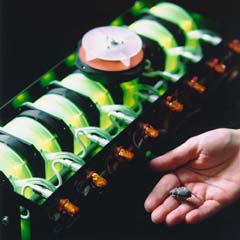


This photo shows a Trigonoscelis gigas beetle used during an experiment to determine the effects of light and microgravity on insect circadian rhythms. Sixty-four beetles were flown to the Russian Mir Space Station in two "beetle kits." Each kit contained 32 Beetle Activity Monitors (BAMs). A chassis containing 8 BAMs is shown in the photo. Each BAM was capable of providing food, light and ventilation to one beetle during space flight.
![]()
|
|
Curator:
Julie Oliveaux
Responsible NASA Official: John Uri |
Page last updated: 07/16/1999
.gif)